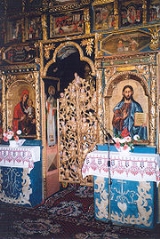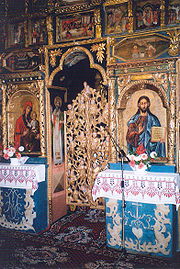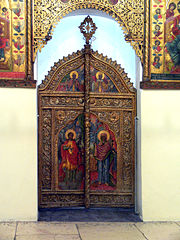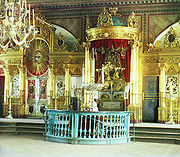
Royal Doors
Encyclopedia

Iconostasis
In Eastern Christianity an iconostasis is a wall of icons and religious paintings, separating the nave from the sanctuary in a church. Iconostasis also refers to a portable icon stand that can be placed anywhere within a church...
in an Eastern Orthodox
Eastern Orthodox Church
The Orthodox Church, officially called the Orthodox Catholic Church and commonly referred to as the Eastern Orthodox Church, is the second largest Christian denomination in the world, with an estimated 300 million adherents mainly in the countries of Belarus, Bulgaria, Cyprus, Georgia, Greece,...
or Greek-Catholic Church.
In Orthodox Churches, the sanctuary
Sanctuary
A sanctuary is any place of safety. They may be categorized into human and non-human .- Religious sanctuary :A religious sanctuary can be a sacred place , or a consecrated area of a church or temple around its tabernacle or altar.- Sanctuary as a sacred place :#Sanctuary as a sacred place:#:In...
(the entire space of which is referred to as the "altar" among Eastern Christians) is separated from the nave
Nave
In Romanesque and Gothic Christian abbey, cathedral basilica and church architecture, the nave is the central approach to the high altar, the main body of the church. "Nave" was probably suggested by the keel shape of its vaulting...
by a wooden screen called the iconostasis. The iconostasis represents Christian continuity from the veil of the Temple in Jerusalem which separated the people from the Holy of Holies that housed the Ark of the Covenant. Normally, the iconostasis has three doors in it. The two single doors to the right and left are called "deacons' doors" or "angel doors" and they usually have on them icons of either sainted deacon
Deacon
Deacon is a ministry in the Christian Church that is generally associated with service of some kind, but which varies among theological and denominational traditions...
s (Saint Stephen
Saint Stephen
Saint Stephen The Protomartyr , the protomartyr of Christianity, is venerated as a saint in the Roman Catholic, Anglican, Lutheran, Oriental Orthodox and Eastern Orthodox Churches....
, Saint Lawrence
Saint Lawrence
Lawrence of Rome was one of the seven deacons of ancient Rome who were martyred during the persecution of Valerian in 258.- Holy Chalice :...
, etc.) or the Archangels Michael
Michael (archangel)
Michael , Micha'el or Mîkhā'ēl; , Mikhaḗl; or Míchaël; , Mīkhā'īl) is an archangel in Jewish, Christian, and Islamic teachings. Roman Catholics, Anglicans, and Lutherans refer to him as Saint Michael the Archangel and also simply as Saint Michael...
and Gabriel
Gabriel
In Abrahamic religions, Gabriel is an Archangel who typically serves as a messenger to humans from God.He first appears in the Book of Daniel, delivering explanations of Daniel's visions. In the Gospel of Luke Gabriel foretells the births of both John the Baptist and of Jesus...
. These are the doors that the clergy will normally use when entering the altar. The central double doors are the "holy doors" (Slavonic: Svyatýa Vratá), which are considered to be most sacred, and may only be entered at certain sacred moments during the services, and only by ordained clergy (deacons, priests, bishops).

Divine Liturgy
Divine Liturgy is the common term for the Eucharistic service of the Byzantine tradition of Christian liturgy. As such, it is used in the Eastern Orthodox and Eastern Catholic Churches. Armenian Christians, both of the Armenian Apostolic Church and of the Armenian Catholic Church, use the same term...
(and most especially during the Liturgy of the Presanctified Gifts
Liturgy of the Presanctified Gifts
The Liturgy of the Presanctified Gifts, informally Presanctified Liturgy, is an Eastern Christian liturgical service for the distribution of communion on the weekdays of Great Lent....
). More properly, however, these doors should be called the "Beautiful Gate", and in Greek this is the only term used, although the official English sites of the Ecumenical Patriarchate http://www.patriarchate.org/ecumenical_patriarchate/tour_stgeorge_church.php, the Orthodox Church in America
Orthodox Church in America
The Orthodox Church in America is an autocephalous Eastern Orthodox church in North America. Its primate is Metropolitan Jonah , who was elected on November 12, 2008, and was formally installed on December 28, 2008...
http://www.oca.org/QA.asp?ID=100&SID=3 and the Antiochian Orthodox Church
Antiochian Orthodox Church
The Greek Orthodox Church of Antioch, also known as the Greek Orthodox Patriarchate of Antioch and All the East and the Antiochian Orthodox Church , is an autocephalous Greek Orthodox Church within the wider communion of Orthodox Christianity...
http://www.antiochian.org/theology/first_visit.htm all use the term "Royal Doors". In Russia, they are sometimes called the "Red Gates", red being synonymous with beautiful.
Annunciation
The Annunciation, also referred to as the Annunciation to the Blessed Virgin Mary or Annunciation of the Lord, is the Christian celebration of the announcement by the angel Gabriel to Virgin Mary, that she would conceive and become the mother of Jesus the Son of God. Gabriel told Mary to name her...
in the form of a diptych
Diptych
A diptych di "two" + ptychē "fold") is any object with two flat plates attached at a hinge. Devices of this form were quite popular in the ancient world, wax tablets being coated with wax on inner faces, for recording notes and for measuring time and direction.In Late Antiquity, ivory diptychs with...
(the Theotokos
Theotokos
Theotokos is the Greek title of Mary, the mother of Jesus used especially in the Eastern Orthodox, Oriental Orthodox, and Eastern Catholic Churches. Its literal English translations include God-bearer and the one who gives birth to God. Less literal translations include Mother of God...
on the right door, and the Archangel Gabriel on the left), either alone or with the four Evangelists
Four Evangelists
In Christian tradition the Four Evangelists are Matthew, Mark, Luke, and John, the authors attributed with the creation of the four Gospel accounts in the New Testament that bear the following titles:*Gospel according to Matthew*Gospel according to Mark...
. Other icons may be used also. The doors may be intricately carved and gilded, and are almost always topped by a cross.
Theologically the Holy Doors represent the gates of Jerusalem, through which Christ entered on Palm Sunday
Palm Sunday
Palm Sunday is a Christian moveable feast that falls on the Sunday before Easter. The feast commemorates Jesus' triumphal entry into Jerusalem, an event mentioned in all four Canonical Gospels. ....
. They also represent the entrance to the Heavenly Jerusalem. In the Russian practice
Russian Orthodox Church
The Russian Orthodox Church or, alternatively, the Moscow Patriarchate The ROC is often said to be the largest of the Eastern Orthodox churches in the world; including all the autocephalous churches under its umbrella, its adherents number over 150 million worldwide—about half of the 300 million...
, there are detailed rules as to when the doors are to be opened during Vespers
Vespers
Vespers is the evening prayer service in the Western Catholic, Eastern Catholic, and Eastern Orthodox, Anglican, and Lutheran liturgies of the canonical hours...
, Matins
Matins
Matins is the early morning or night prayer service in the Roman Catholic, Anglican, Lutheran and Eastern Orthodox liturgies of the canonical hours. The term is also used in some Protestant denominations to describe morning services.The name "Matins" originally referred to the morning office also...
and the Divine Liturgy.http://www.oca.org/QA.asp?ID=100&SID=3 When the gates are opened, it represents moments when God is especially present to his people, such as during the reading of the Gospel
Gospel
A gospel is an account, often written, that describes the life of Jesus of Nazareth. In a more general sense the term "gospel" may refer to the good news message of the New Testament. It is primarily used in reference to the four canonical gospels of Matthew, Mark, Luke, and John...
, or when the faithful are receiving Holy Communion. Most of the time the doors are closed. This is symbolic of penitence, a reminder that sin separates the individual from God.

Temple in Jerusalem
The Temple in Jerusalem or Holy Temple , refers to one of a series of structures which were historically located on the Temple Mount in the Old City of Jerusalem, the current site of the Dome of the Rock. Historically, these successive temples stood at this location and functioned as the centre of...
in Jerusalem, behind the Holy Doors which is opened and closed at specific times during the services. While the veil is always open whenever the Holy Doors are opened, sometimes when the Holy Doors are closed, the rubrics call for the veil to be opened. The curtain is usually more plainly decorated. Alternatively a sliding panel depicting "Christ the Great High Priest
High priest
The term "high priest" usually refers either to an individual who holds the office of ruler-priest, or to one who is the head of a religious caste.-Ancient Egypt:...
" may take place of the doors and curtain and certain churches may have no physical barrier at all.http://www.oca.org/QA.asp?ID=100&SID=3
Bishop
A bishop is an ordained or consecrated member of the Christian clergy who is generally entrusted with a position of authority and oversight. Within the Catholic Church, Eastern Orthodox, Oriental Orthodox Churches, in the Assyrian Church of the East, in the Independent Catholic Churches, and in the...
s, priest
Priest
A priest is a person authorized to perform the sacred rites of a religion, especially as a mediatory agent between humans and deities. They also have the authority or power to administer religious rites; in particular, rites of sacrifice to, and propitiation of, a deity or deities...
s, and deacons) are permitted to go through the Holy Doors, and even they may only pass through them when it is prescribed by the liturgical rubrics.
During Bright Week
Bright Week
Bright Week or Renewal Week is the name used by the Eastern Orthodox Church and Eastern Catholic Churches of the Byzantine Rite for the period of seven days beginning on Pascha and continuing up to the following Sunday, which is known as Thomas Sunday...
(the week following Easter Sunday), the Holy Doors and veil remain open the entire week. During this time, the open doors symbolize the open Tomb of Christ. The Epitaphios
Epitaphios
Epitaphios may refer to:* Funeral oration or epitaphios logos* Epitaphios or epitaphion, a cloth icon used during Holy Week in churches that follow the Byzantine rite...
(icon representing the burial shroud
Shroud
Shroud usually refers to an item, such as a cloth, that covers or protects some other object. The term is most often used in reference to burial sheets, winding-cloths or winding-sheets, such as the famous Shroud of Turin or Tachrichim that Jews are dressed in for burial...
of Christ) is visible on top of the Holy Table (altar table) through the open Holy Doors as a witness of the Resurrection. During Bright Week, the clergy, who would normally use the Deacons Doors to go in and out of the sanctuary, will always enter and exit through the Holy Doors

In addition to referring to the Holy Doors, the term "Royal Doors" can also (and more properly) refer to either of the following:
- Most correctly, the term "Royal Doors" indicates the large central doors that separate the narthexNarthexThe narthex of a church is the entrance or lobby area, located at the end of the nave, at the far end from the church's main altar. Traditionally the narthex was a part of the church building, but was not considered part of the church proper...
from the nave. This is the formal entrance to the church proper (ie, the nave) and was, in former times, the ceremonial entrance of the Emperor, hence the epithet 'royal'. In current use these doors are used by all although monasteries and some parish churches use the doors liturgically as the point where the abbot or a bishop vests before making a formal entrance.
- A third use of "Royal Doors" is to indicate the outside entrance into the church. This is appears to be a rare usage but appropriate to those churches that do not have a physical separation between the narthex and the nave.
External links
- Royal Doors and Iconostasis Dr. Alexander Roman

